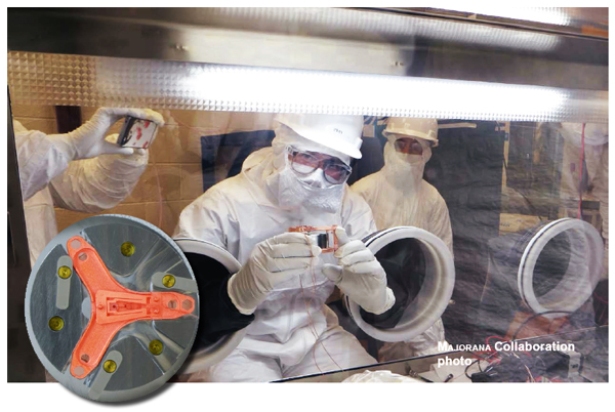Dec 20 2012
On Dec. 6, working nearly a mile underground in the cleanest space in South Dakota, Ryan Martin of Berkeley Lab’s Nuclear Science Division (NSD) assembled the first of 70 detector units for the MAJORANA DEMONSTRATOR experiment. Each unit consists of a polished slice of pure germanium crystal the size of a hockey puck, attached to an electronics board on a wafer-thin disk of fused silica.
 Ryan Martin assembles a detector unit in the glove box of the MAJORANA DEMONSTRATOR assembly room. Inset is the low-mass front-end board with electronics mounted on a copper leaf spring.
Ryan Martin assembles a detector unit in the glove box of the MAJORANA DEMONSTRATOR assembly room. Inset is the low-mass front-end board with electronics mounted on a copper leaf spring.
MAJORANA DEMONSTRATOR, now under construction in the ultraclean facilities of the Davis Campus on the 4,850-foot level of the Sanford Underground Research Facility (Sanford Lab), will look for the as-yet-unseen phenomenon of neutrinoless double-beta decay. The current executive committee chair of the MAJORANA Collaboration, comprised of more than 100 researchers from the U.S., Canada, Russia, and Japan, is Berkeley Lab’s Alan Poon.
Martin took about two and a half hours to assemble the first detector. Although he’d practiced the task many times back at the Lab, he’d never assembled a detector unit while wearing four pairs of protective gloves. The MAJORANA DEMONSTRATOR requires protection from all possible sources of radiation, so it’s underground to shield it from cosmic radiation. And because the surrounding rock is also a source of radiation, the germanium detectors will be placed in cryostats made of ultra-pure copper that, in turn, will be inside a copper shield, inside a lead igloo.
But the detectors have to be protected from radiation during assembly as well – including radioactive sources like machinery, specks of dust, and people. Everyone working in the assembly room wears hooded Tyvek coveralls and two pairs of nitrile gloves. The units are assembled inside a nitrogen-filled glove box inside the clean room, which was commissioned with Martin’s assistance as well as that of Berkeley Lab’s Yuen-dat Chan and Susanne Mertens. Once he inserts his already-double-gloved hands into the glove box gloves, Martin dons a fourth pair of gloves positioned inside the box.
Then the delicate work begins. Each germanium crystal must be precisely connected to a fused silica low-mass front-end board (LMFE) carrying the electronic circuits that relay signals of nuclear decay, a design developed at Berkeley Lab, with cables and electronics components prepared by Nicolas Abgrall and Paul Barton of NSD and Harold Yaver of Engineering. The LMFE is mounted on a copper leaf spring, and a pin makes the connection with the germanium.
The first detectors are prototypes made from natural germanium, used to test the experiment. The actual experiment will use germanium highly enriched in the scarce isotope 76Ge, one of the few isotopes capable of rare double-beta decay and even rarer (presuming it exists) neutrinoless double-beta decay.
Germanium is ideal for signaling nuclear decays cleanly, so MAJORANA’s detectors will signal any such decay as soon as it happens. The first two enriched detectors have been completed by ORTEC, a contractor in Tennessee. Enriched germanium will begin arriving at the Sanford Lab early next year.